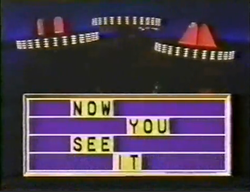Now You See It (U.S. game show)
| Now You See It | |
|---|---|
 |
|
| Created by | Frank Wayne |
| Directed by |
Paul Alter (1974–75) Andrew Felsher (1989) |
| Presented by |
Jack Narz (1974–75) Chuck Henry (1989) |
| Narrated by |
Johnny Olson (1974–75) Mark Driscoll (April 1989) Don Morrow (May–July 1989) |
| Theme music composer | Quincy Jones, Bill Cosby |
| Opening theme | Chump Change |
| Country of origin | United States |
| Original language(s) | English |
| No. of seasons | 1 (1974–75 version) 1 (1989 version) |
| No. of episodes | 308 (1974–75 version) 75 (1989 version) |
| Production | |
| Executive producer(s) | Frank Wayne (1974–75) Jonathan Goodson (1989) |
| Producer(s) | Buck D'Amore (1974–75) Gary Dawson (1989) Andrew Felsher (co-producer, 1989) |
| Location(s) |
CBS Television City Hollywood, California |
| Running time | 22–26 minutes |
| Production company(s) | Goodson-Todman Productions |
| Distributor | FremantleMedia |
| Release | |
| Original network | CBS |
| Picture format | NTSC |
| Original release | April 1, 1974 – June 13, 1975 April 3, 1989 – July 14, 1989 |
Now You See It is an American television game show created by Frank Wayne for Mark Goodson-Bill Todman Productions. The object of Now You See It was to answer general knowledge trivia questions by finding the answers which were hidden on a grid similar to a word search puzzle.
Two seasons were produced, both of which aired on CBS. The first series ran from April 1, 1974 until June 13, 1975, and was hosted by Jack Narz. Johnny Olson was the original announcer, with Gene Wood substituting on occasion. The second series ran from April 3 until July 14, 1989, and was emceed by veteran Los Angeles news anchor Chuck Henry. Los Angeles disc jockey Mark Driscoll announced for the first month of the 1989 season, with Don Morrow replacing him for the remainder of the run.
The first round of Now You See It under its original format began with four new contestants split into two teams, each with one "outside" and one "inside" contestant. This round, called the Elimination Round, was played on an electronic game board on the opposite side of the stage from the contestant desks. The board consisted of four numbered lines, with fourteen letters in each line. The letters were referred to as "positions" for scoring purposes. The board was shown to the contestants momentarily, then quickly turned off before any of them could fully memorize it.
To start the round, the "outside" contestants turned their backs to the board as Narz read a question. The first "inside" contestant to buzz-in would say which line the correct answer appeared on. If the correct line was given, it remained lit and the "outside" contestant for that team turned around to give the position of the first letter of the word, then give the answer that Narz was looking for; the entire response would therefore be in the form of "line x, position x, word". If the wrong line was guessed, the other team got a free guess.
Words were not scored by length. Instead, the position of the word's first letter was added to the number of the line it was on to determine a team's score. For instance, a word that started in the first position of the first line (line one, position one) would be worth two points, whereas a word on the same line but with the first letter in the eighth position (line one, position eight) would be worth nine points. Halfway through the round, a bell would ring and the teammates would switch seats. This occurred after six questions had been asked; after another six were asked, the bell rang again and the team that was in the lead when it rang the second time won the Elimination Round.
...
Wikipedia
